Solar Eclipse Memory Game
Choose a difficulty level and then click the tiles (squares) to reveal images related to eclipses of the Sun and the November 2012 solar eclipse visible from Australia in particular. Each image is on two tiles. Try to match them all. After you've mastered this game, check out other UCAR Center for Science Education games and interactives.
This game was developed as part of the Eclipse Megamovie Project 2012. Click on the images below to learn more about the pictures used in this game and about the November 2012 total solar eclipse visible from Australia:
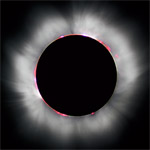 |
The Sun's chromosphere (red) and corona as seen from France during a total solar eclipse on August 11, 1999. Photo by Luc Viatour. |
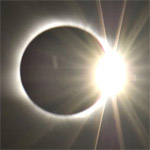 |
Diamond Ring and Bailey's Beads as seen from Russia during a total solar eclipse on August 1, 2008. Credit: Sandy kil at ru.wikipedia (Russian Wikipedia) |
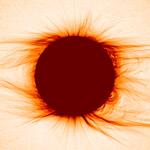 |
Total solar eclipse as seen from Curacao in the Netherlands Antilles on February 26, 1998. Credit: High Altitude Observatory (HAO) at the National Center for Atmospheric Research (NCAR) in Boulder, Colorado. |
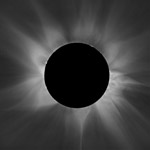 |
Total solar eclipse as seen from Palem, India on February 16, 1980. The appearance of the corona (Sun's upper atmosphere) in this photo is typical of the "solar max" phase of the sunspot cycle. Credit: High Altitude Observatory (HAO) at the National Center for Atmospheric Research (NCAR) in Boulder, Colorado and Rhodes College in Memphis, Tennessee. |
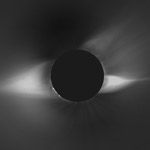 |
Total solar eclipse as seen from Putre, Chile on November 3, 1994. The appearance of the corona (Sun's upper atmosphere) in this photo is typical of the "solar min" phase of the sunspot cycle. Credit: High Altitude Observatory (HAO) at the National Center for Atmospheric Research (NCAR) in Boulder, Colorado. |
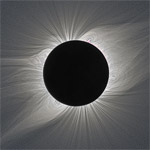 |
Total solar eclipse as seen from Novosibirsk, Russia on August 1, 2008. Credit: Williams College Expedition - Jay M. Pasachoff, Bryce A. Babcock, William G. Wagner, Matthew Baldwin, Katherine DuPré, Marcus Freeman, Marek Demianski, and Paul Rosenthal, in collaboration with Alphya Nesterenko and Igor Nesterenko of the State University of Novosibirsk, Akademgorodok, Russia. Image processing by Haná Druckmüllerová, Brno Technical University, Czech Republic.. |
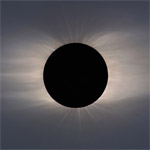 |
Total solar eclipse as seen from Hangzhou, China on July 22, 2009. Credit: Williams College Eclipse Expedition - Jay M. Pasachoff, Wendy Carlos, Jon Kern, Sara Dwyer and Rachel Wagner-Kaiser. |
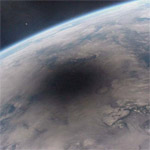 |
The shadow of the Moon on Earth as seen from the Mir space station in Earth orbit during the solar eclipse on August 11 1999. Credit: Mir 27 crew, copyright CNES. |
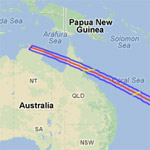 |
A Google Maps view of the path of the November 2012 solar eclipse over northeastern Australia. Credit: Eclipse Predictions by Fred Espenak, NASA's GSFC. |
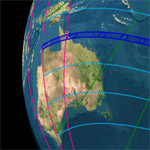 |
Another view of the path of the November 2012 solar eclipse over northeastern Australia and the southern Pacific Ocean, projected onto a globe. Credit: Eclipse Predictions by Fred Espenak, NASA's GSFC. |
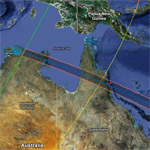 |
Another Google Maps view of the path of the November 2012 solar eclipse over northeastern Australia and the southern Pacific Ocean. Credit: Xavier M. Jubier. |
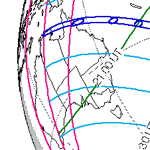 |
Another view of the path of the November 2012 solar eclipse over northeastern Australia and the southern Pacific Ocean, projected onto a globe. Credit: Eclipse Predictions by Fred Espenak, NASA's GSFC. |
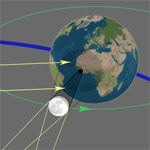 |
Geometry of the Sun, Moon and Earth during a total solar eclipse. The dark, inner shadow of the Moon where a total eclipse is seen is called the umbra. The lighter, outer shadow, where a partial eclipse can be viewed, is called the penumbra. Credit: Sagredo (from Wikipedia). |
© 2012 UCAR